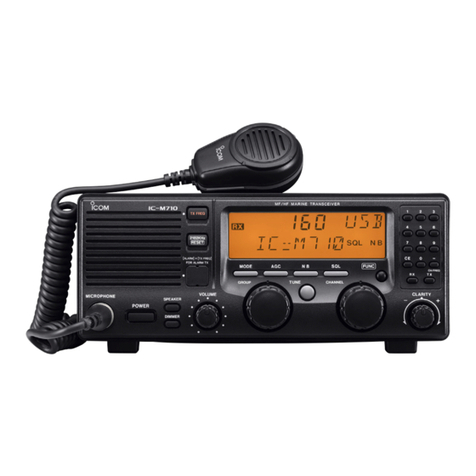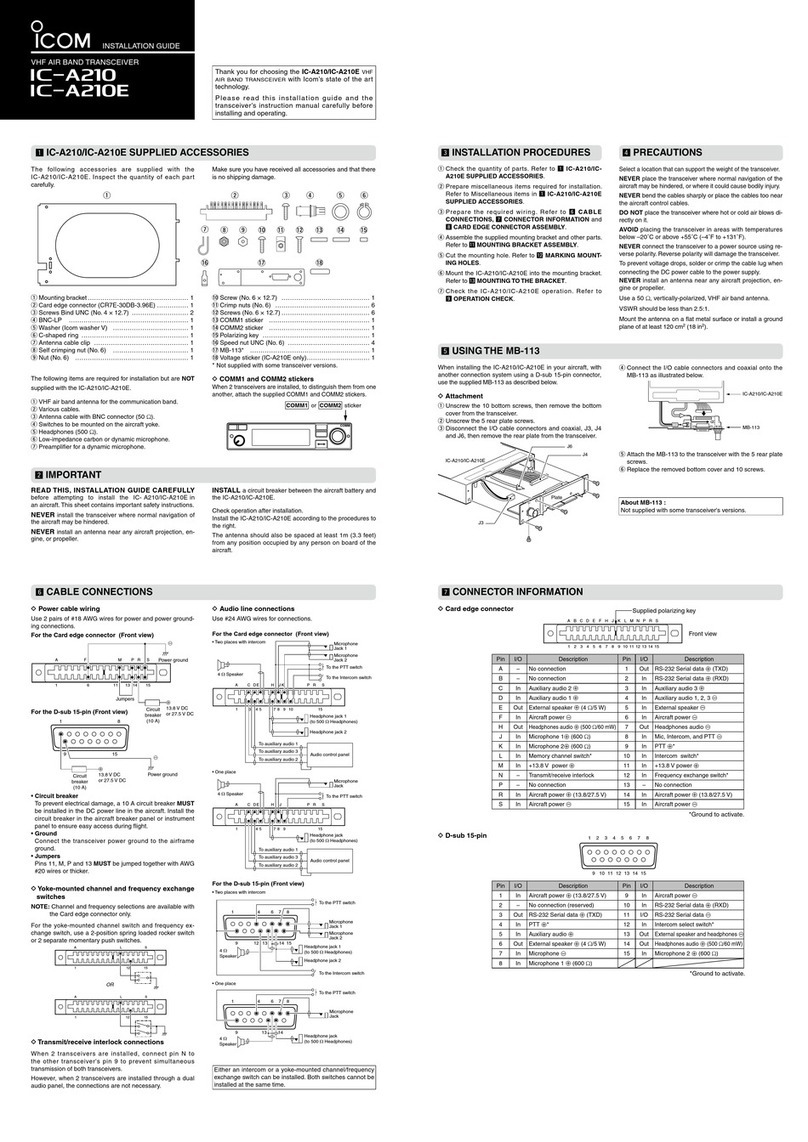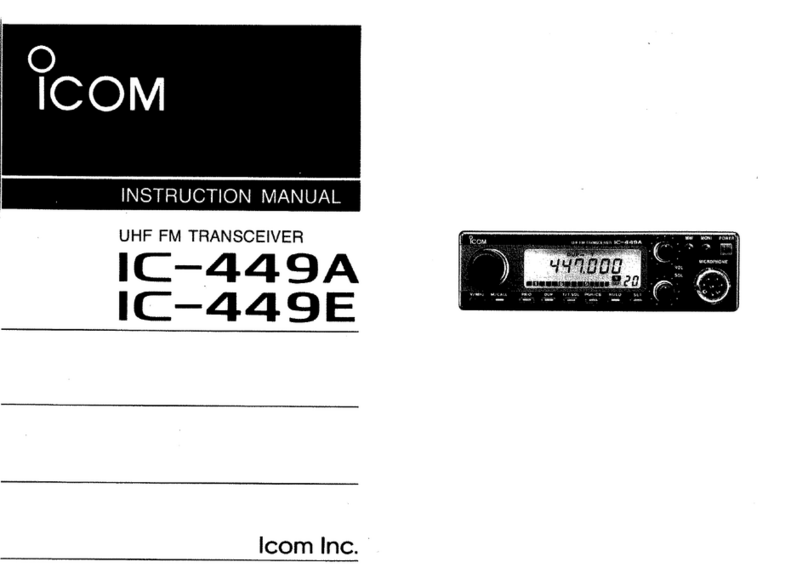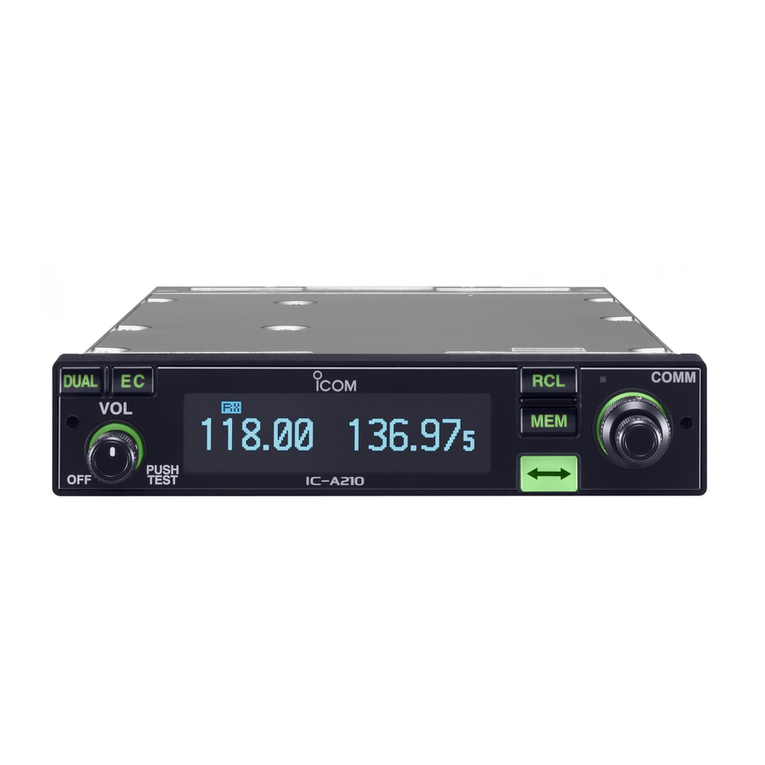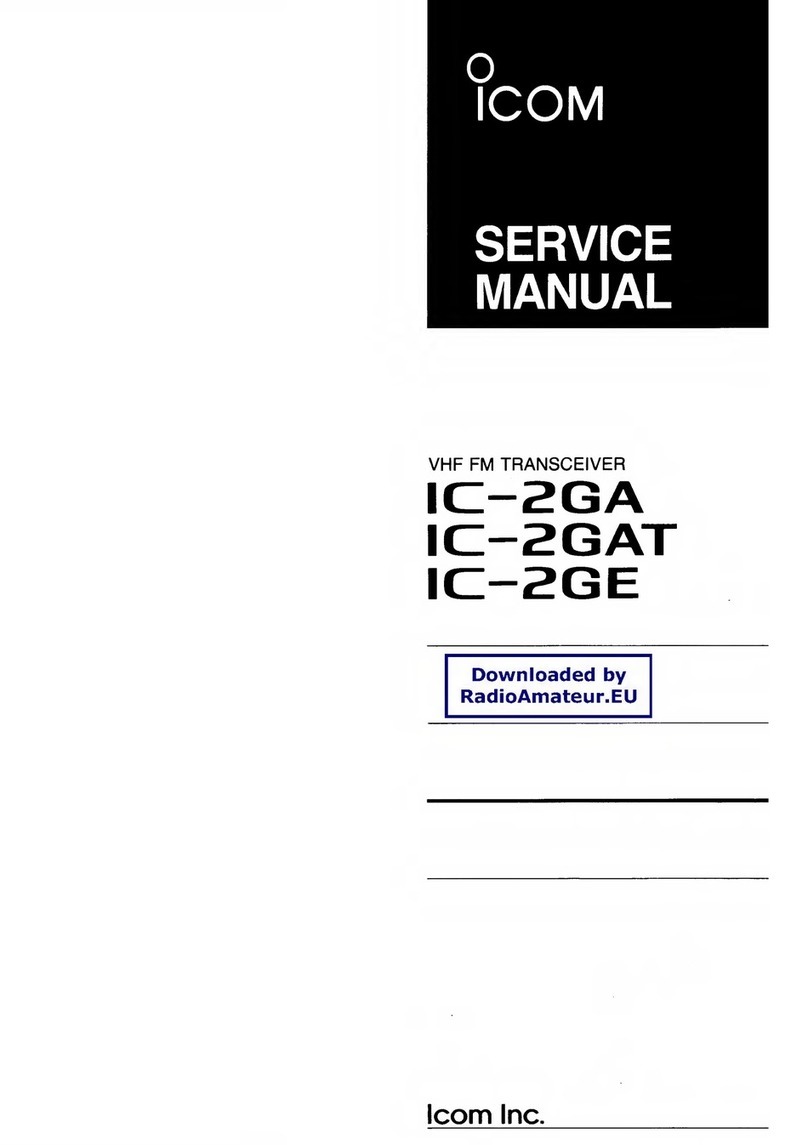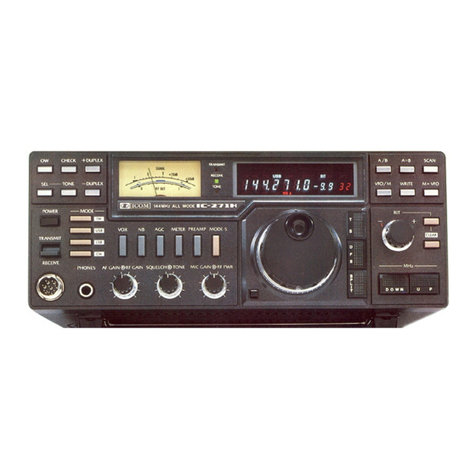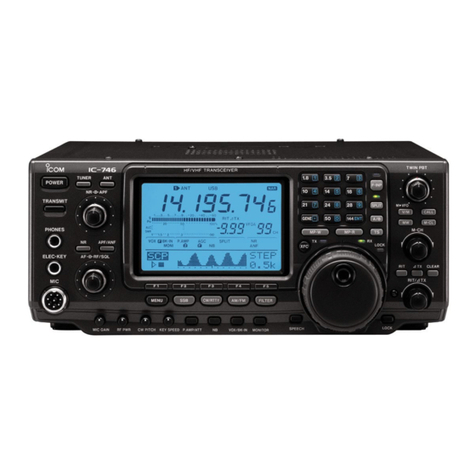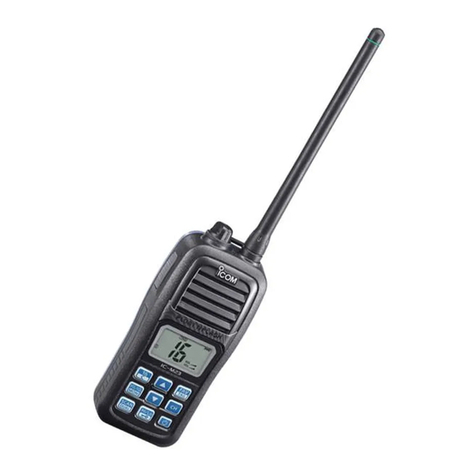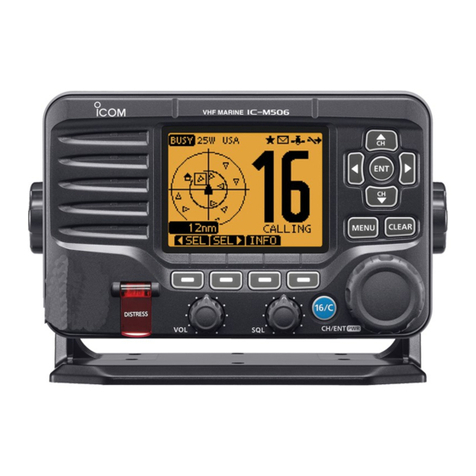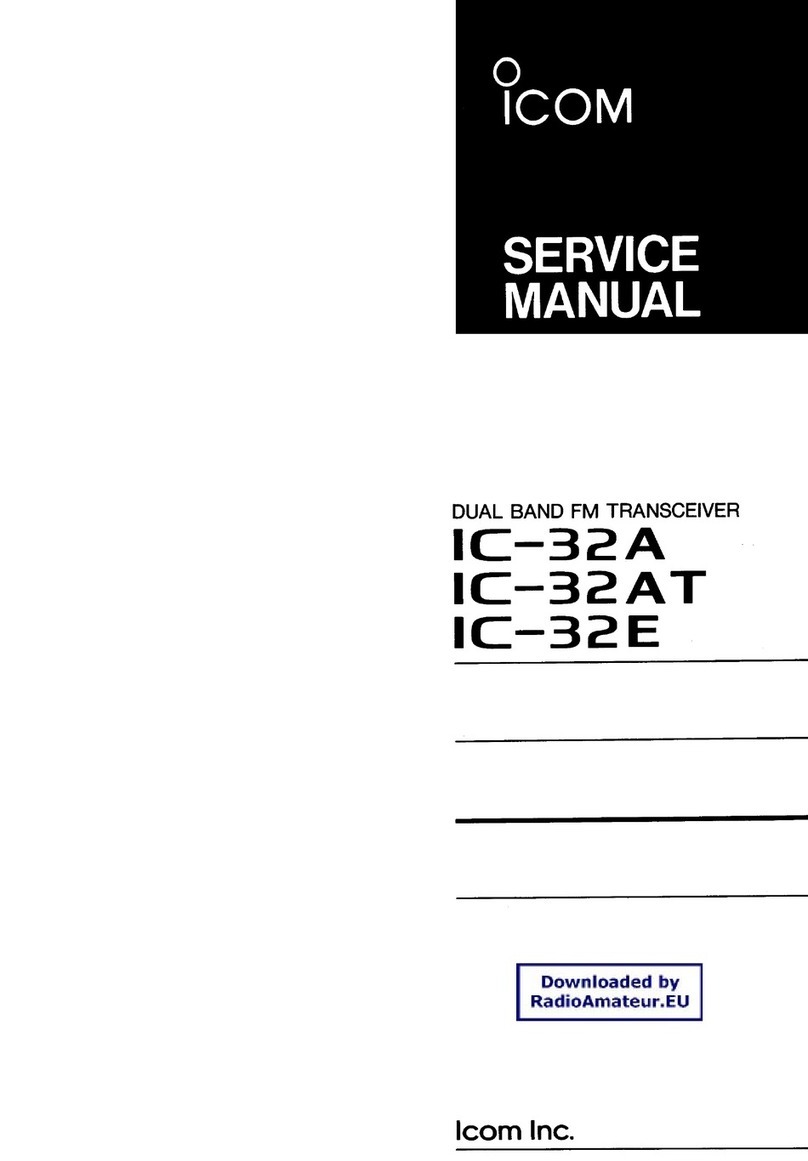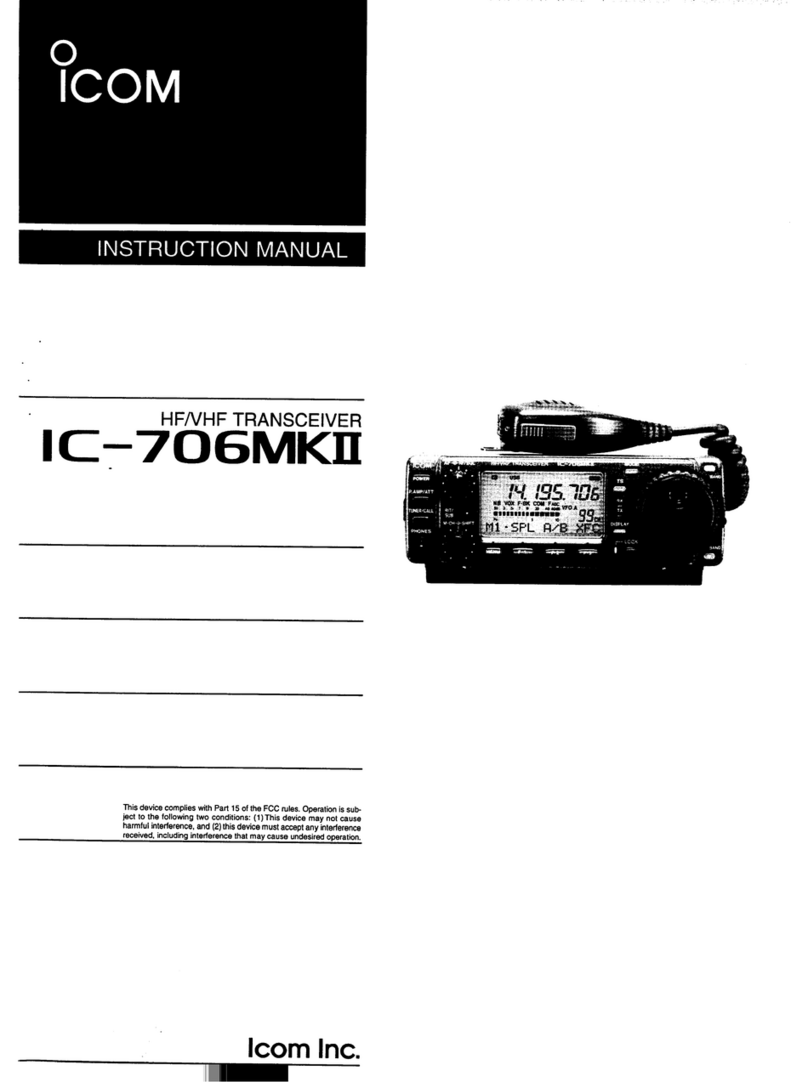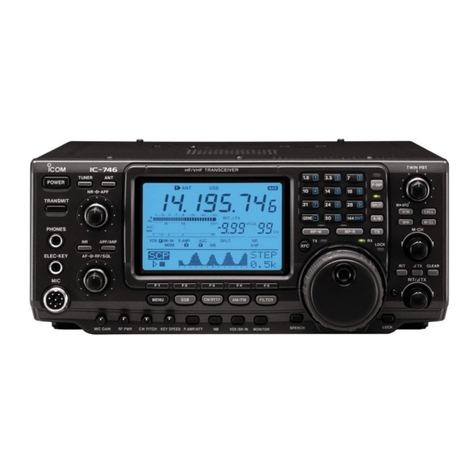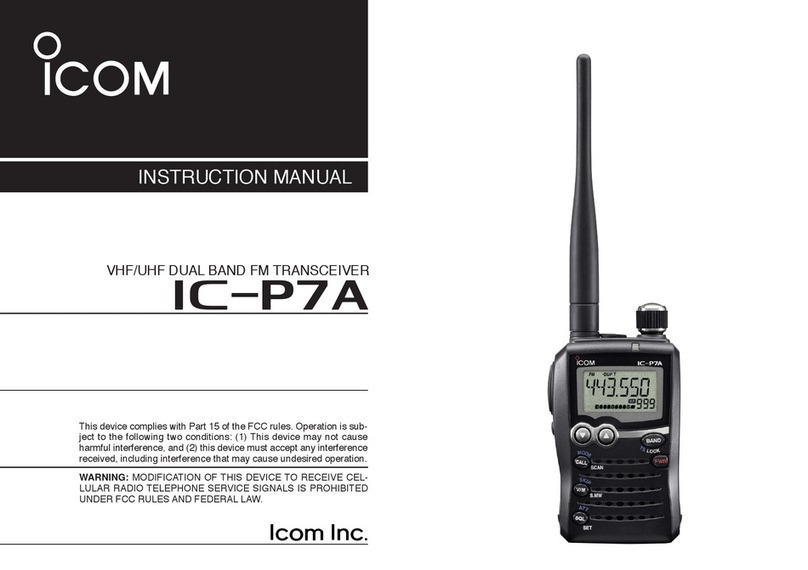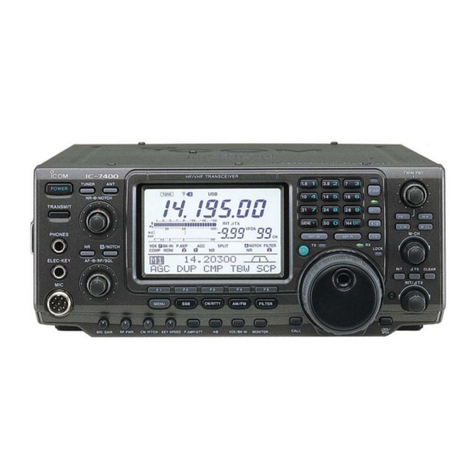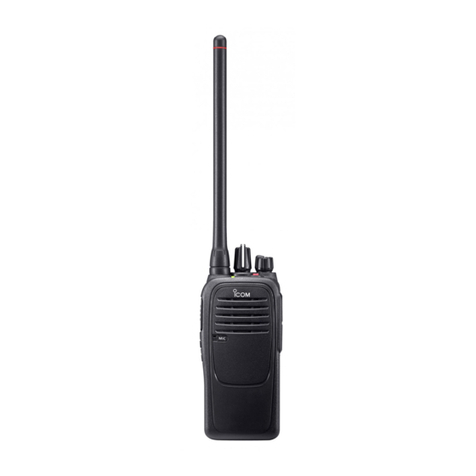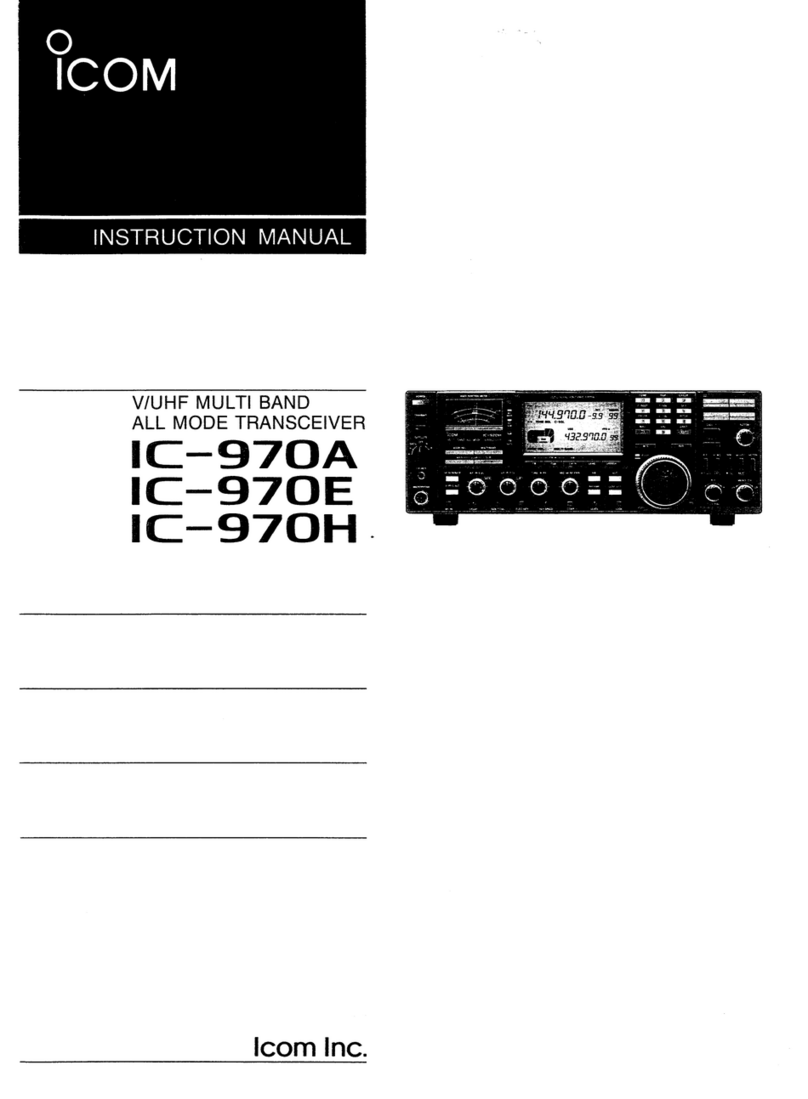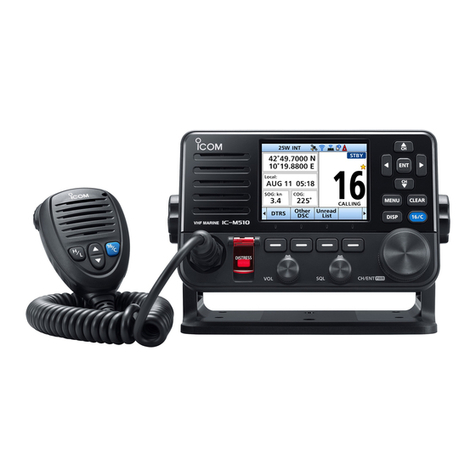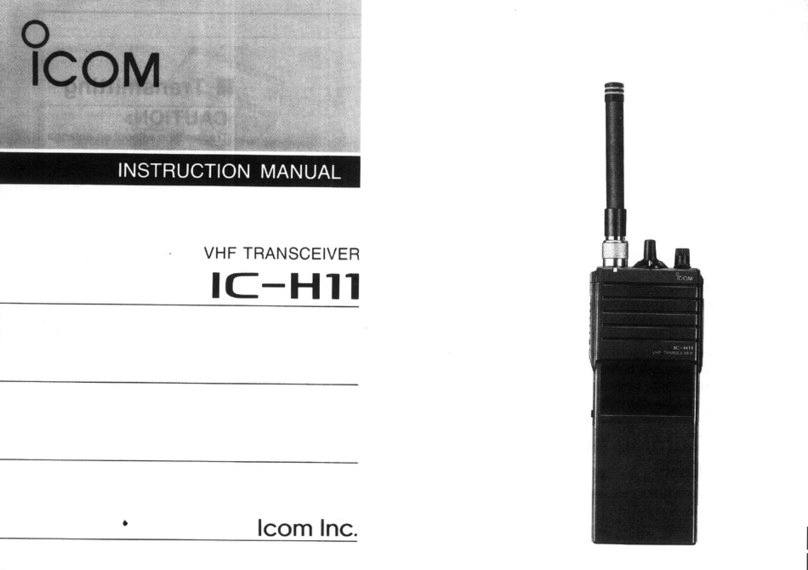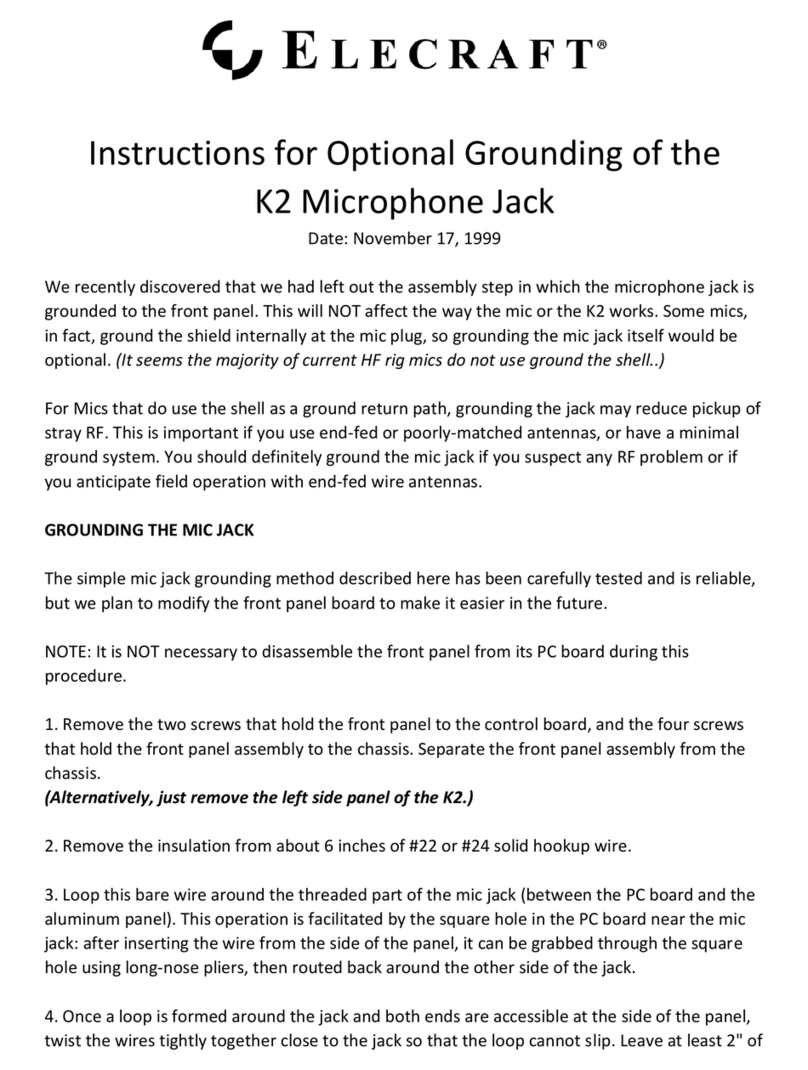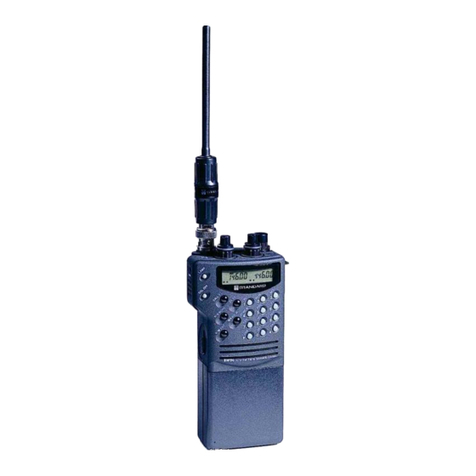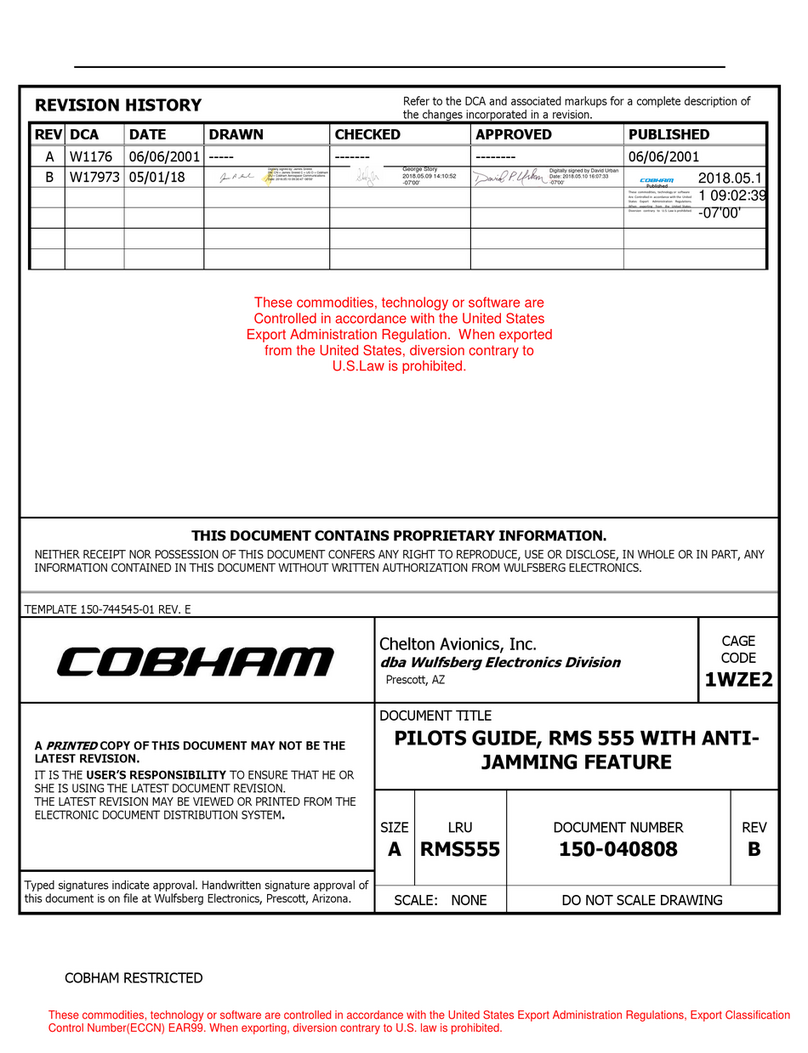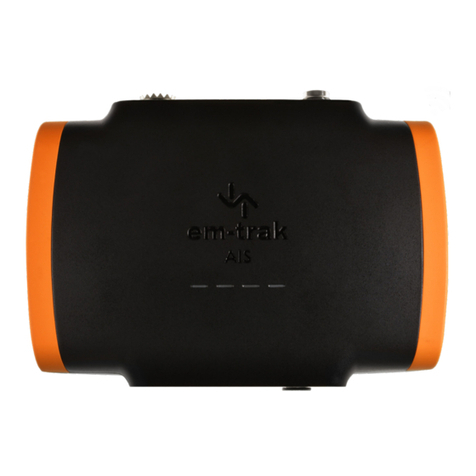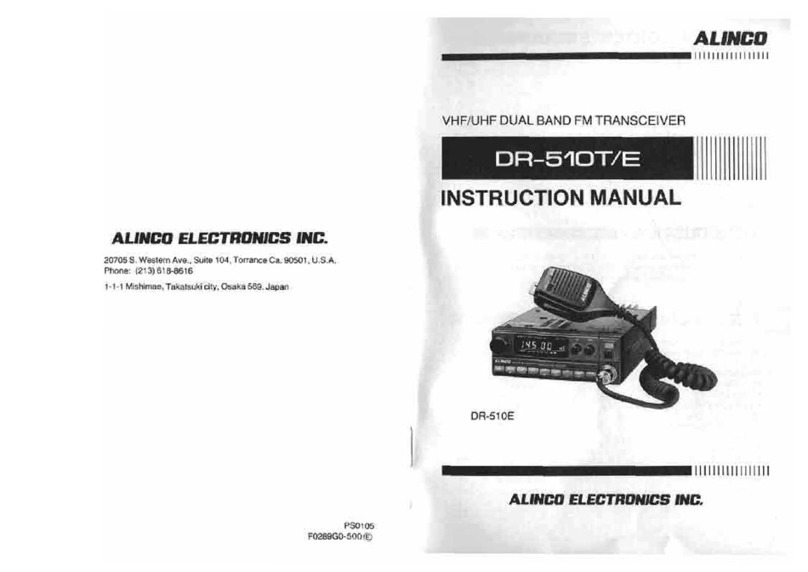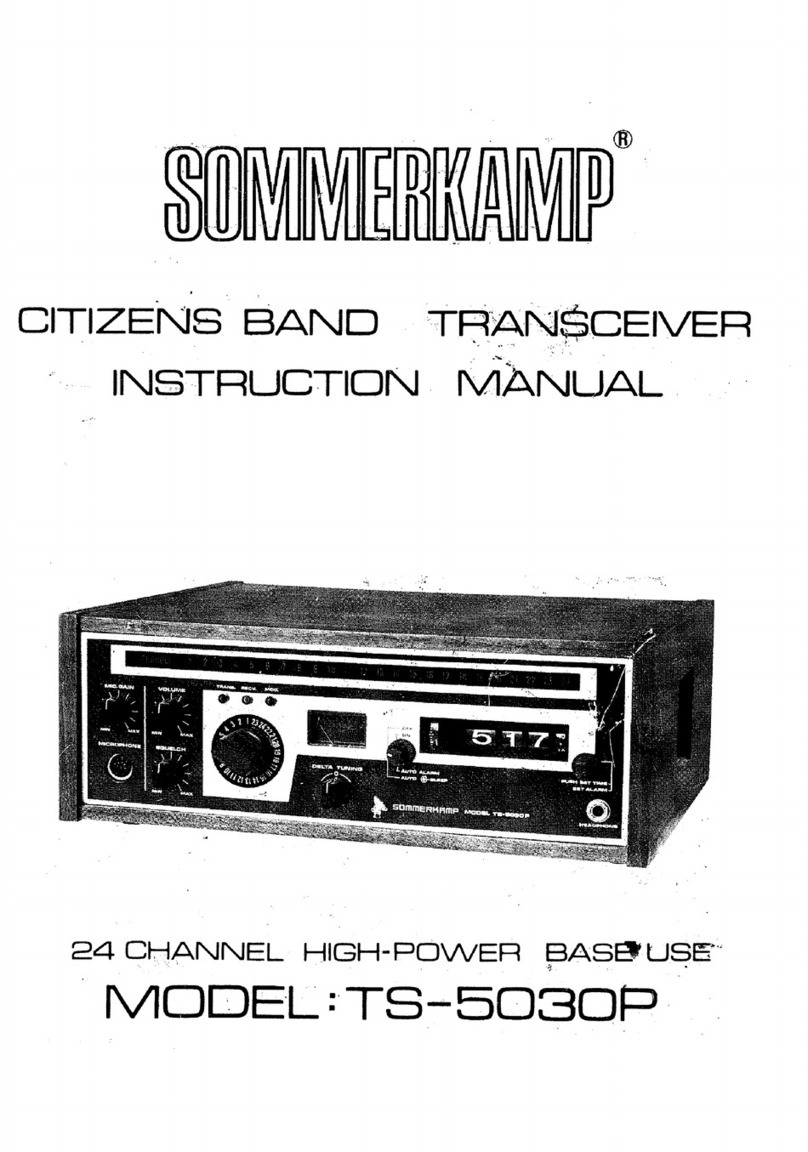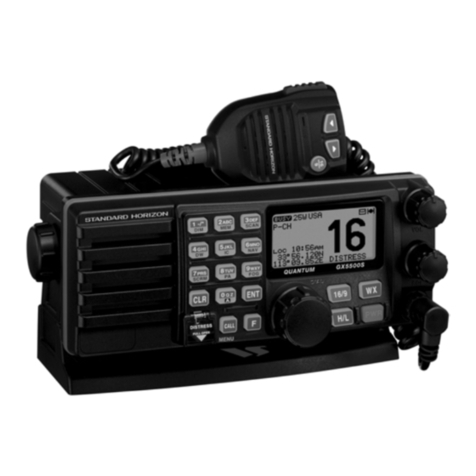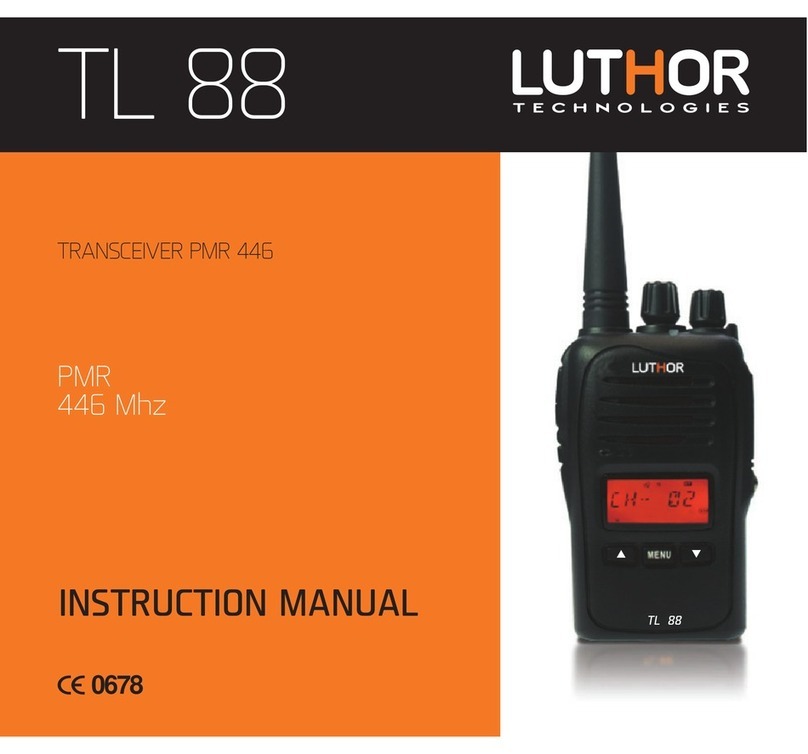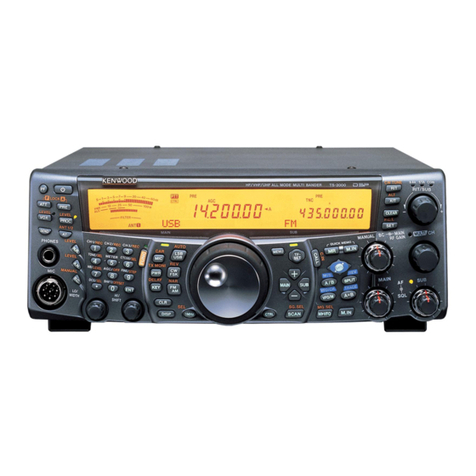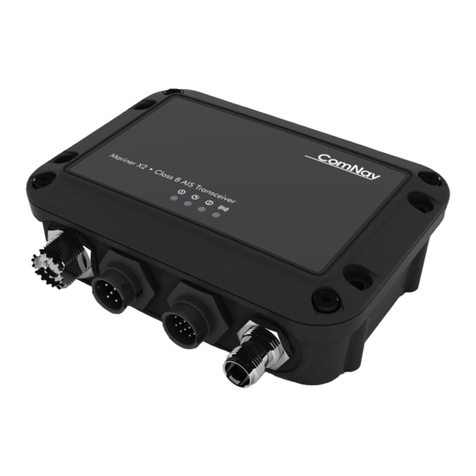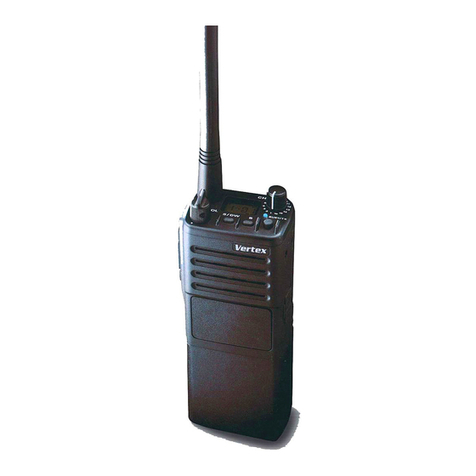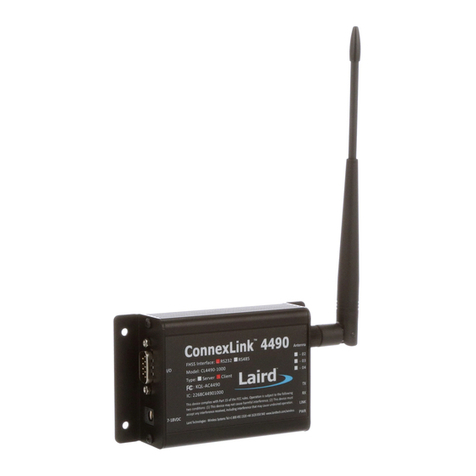Icom IC-703 User manual

HF/50 MHz
ALL MODE TRANSCEIVER
i703
INSTRUCTION MANUAL

i
FOREWORD
Thank We understand that you have a choice of many
different radios in the market place. We want to take a
couple of moments of your time to thank you for mak-
ing the IC-703 your radio of choice, and hope you
agree with Icom’s philosophy of “technology first.”
Many hours of research and development went into
the design of your IC-703.
FEATURES
❍
DSP features (AF DSP; UT-106
DSP UNIT
required
some version)
❍
All mode capability covering 160–6 m
❍
9.0–15.87 V operation
❍
Compact with detachable front panel
❍
±0.5 ppm of high frequency stability
❍
Built in antenna tuner
❍
Simple band scope function
IMPORTANT
READ THIS INSTRUCTION MANUAL
CAREFULLY before attempting to operate the
transceiver.
SAVE THIS INSTRUCTION MANUAL. This
manual contains important safety and operating in-
structions for the IC-703.
EXPLICIT DEFINITIONS
RWARNING RF EXPOSURE! This device emits
Radio Frequency (RF) energy. Extreme caution should be
observed when operating this device. If you have any
questions regarding RF exposure and safety standards
please refer to the Federal Communications Commission
Office of Engineering and Technology’s report on Evalu-
ating Compliance with FCC Guidelines for Human Radio
Frequency Electromagnetic Fields (OET Bulletin 65).
RWARNING HIGH VOLTAGE! NEVER attach an
antenna or internal antenna connector during transmis-
sion. This may result in an electrical shock or burn.
RNEVER apply AC to the [DC13.8V] receptacle on the
transceiver rear panel. This could cause a fire or damage
the transceiver.
RNEVER apply more than 16 V DC, such as a 24 V
battery, to the [DC13.8V] receptacle on the transceiver
rear panel. This could cause a fire or damage the trans-
ceiver.
RNEVER let metal, wire or other objects touch any in-
ternal part or connectors on the rear panel of the trans-
ceiver. This may result in an electric shock.
NEVER expose the transceiver to rain, snow or any liquids.
AVOID using or placing the transceiver in areas with tem-
peratures below –10°C (+14°F) or above +60°C (+140°F).
Be aware that temperatures on a vehicle’s dashboard can
exceed 80°C (+176°F), resulting in permanent damage to
the transceiver if left there for extended periods.
AVOID placing the transceiver in excessively dusty envi-
ronments or in direct sunlight.
AVOID placing the transceiver against walls or putting
anything on top of the transceiver. This will obstruct heat
dissipation.
Place unit in a secure place to avoid inadvertent use by
children.
During mobile operation, DO NOT operate the transceiver
without running the vehicle’s engine. When the trans-
ceiver’s power is ON and your vehicle’s engine is OFF,
the vehicle’s battery will soon become exhausted.
Make sure the transceiver power is OFF before starting
the vehicle. This will avoid possible damage to the trans-
ceiver by ignition voltage spikes.
During maritime mobile operation, keep the transceiver
and microphone as far away as possible from the magnetic
navigation compass to prevent erroneous indications.
BE CAREFUL! The rear panel will become hot when op-
erating the transceiver continuously for long periods.
BE CAREFUL! If a linear amplifier is connected, set the
transceiver’s RF output power to less than the linear am-
plifier’s maximum input level, otherwise, the linear ampli-
fier will be damaged.
Use Icom microphones only (supplied or optional). Other
manufacturer’s microphones have different pin assign-
ments, and connection to the IC-703 may damage the
transceiver.
Beat signals may be heard on some frequencies.
These will occur as a result of circuit construction.
For U.S.A. only
Caution: Changes or modifications to this transceiver, not
expressly approved by Icom Inc., could void your authority
to operate this transceiver under FCC regulations.
PRECAUTION
WORD DEFINITION
RRWARNING Personal injury, fire hazard or electric
shock may occur.
CAUTION Equipment damage may occur.
NOTE
If disregarded, inconvenience only. No
risk or personal injury, fire or electric
shock.

ii
SUPPLIED ACCESSORIES
The transceiver comes with the following accessories.
Qty.
qHand microphone (HM-103) .............................. 1
wDC power cable (OPC-1229) ............................. 1
eSpare fuse (FGB 4 A) ........................................ 3
rACC cable ...........................................................1
t3.5 (d) mm plug ...................................................1
y6.5 (d) mm Electronic keyer plug.........................1
uMicrophone hanger..............................................1
TABLE OF CONTENTS
q
er
w
ty u
Icom, Icom Inc. and the logo are registered trademarks of Icom Incorporated (Japan) in the United States, the United King-
dom, Germany, France, Spain, Russia and/or other countries.
FOREWORD …………………………………………… i
IMPORTANT ……………………………………………i
EXPLICIT DEFINITIONS ……………………………… i
PRECAUTION …………………………………………i
TABLE OF CONTENTS ……………………………… ii
QUICK REFERENCE GUIDE ……………… I–X
■Installation ………………………………………… I
1. Grounding your Shack ……………………… I
2. Installing your DC Power Supply ………… I
3. Installing lightning protection ……………… II
4. Installing your antenna system …………… II
5. Connect other peripheral equipment …… III
■Operation ………………………………………… III
1. Voice ………………………………………… III
2. CW…………………………………………… III
3. Other convenient items …………………… IV
■Your first contact ………………………………… IV
DGetting started ………………………………… IV
DJust listening …………………………………… V
1. Select the desired band …………………… V
2. Tune to the desired frequency …………… V
3. Adjust audio output ………………………… V
DWhat are you hearing? ……………………… VI
1. Verify mode ………………………………… VI
2. Reducing interference
(Some functions may require
an optioanl unit depending on version) … VI
■Ready to call CQ? ……………………………… IX
1. Setting up your Mic Gain ………………… IX
2. Speech compressor………………………… X
1 PANEL DESCRIPTION ………………… 1–10
■Front panel ………………………………………… 1
■Multi-function switches …………………………… 4
DM1 functions …………………………………… 4
DM2 functions …………………………………… 4
DM3 functions …………………………………… 4
DM4 functions …………………………………… 5
DS1 functions …………………………………… 6
DS2 functions …………………………………… 6
DS3 functions …………………………………… 6
DS4 functions
(UT-106 is required for some version) ……… 6
■Rear panel ………………………………………… 7
DDATA socket …………………………………… 8
DACC socket……………………………………… 8
■Function display…………………………………… 9
■Microphone (HM-103) ………………………… 10
2
INSTALLATION AND CONNECTIONS
… 11–16
■Unpacking………………………………………… 11
■Selecting a location……………………………… 11
■Grounding………………………………………… 11
■Antenna connection……………………………… 11
■Installation ……………………………………… 12
DSingle body mounting ………………………… 12
DStand …………………………………………… 12
DFront panel separation ……………………… 12
DFront panel mounting ………………………… 12
■Required connections…………………………… 13
■Advanced connections ………………………… 14
■DC Power voltage ……………………………… 15
■DC Power supply connections ………………… 15
■Battery connections …………………………… 15
■External antenna tuners and linear amplifier … 16
1
2
3
4
5
6
7
8
9
10
11
12
13
14
15
16
17
18
19
Quick Reference

iii
3 BASIC OPERATION ……………………17–26
■When first applying power (CPU resetting)…… 17
DM1 display selection ………………………… 17
■Initial settings …………………………………… 17
■VFO description ………………………………… 18
DThe differences between VFO and
memory mode ………………………………… 18
■Frequency setting ……………………………… 19
■Operating mode selection ……………………… 23
■Volume setting …………………………………… 23
■Squelch and receive (RF) sensitivity ………… 24
■Dial lock function ………………………………… 25
■Basic transmit operation ……………………… 25
DTransmitting …………………………………… 25
DMaximum output power ……………………… 25
DSetting output power ………………………… 26
DSetting microphone gain……………………… 26
4 RECEIVE AND TRANSMIT …………… 27–45
■Operating SSB…………………………………… 27
DConvenient functions for receive …………… 27
DConvenient functions for transmit …………… 27
■Operating CW …………………………………… 28
DConnections for CW ………………………… 28
DCW operation ………………………………… 29
DConvenient functions for receive …………… 30
DConvenient functions for transmit …………… 30
DCW reverse mode …………………………… 30
DCW pitch control ……………………………… 31
DElectronic CW keyer ………………………… 31
DCW side tone function………………………… 32
DKeyer set mode ……………………………… 32
■Memory keyer functions………………………… 33
DMemory keyer send menu …………………… 34
DEditing a memory keyer ……………………… 35
DContest number set mode …………………… 36
DMemory keyer set mode……………………… 37
■Operating RTTY ………………………………… 38
DConnections for RTTY (FSK)………………… 38
DRTTY (FSK) operation ……………………… 38
DConvenient functions for receive …………… 39
DRTTY reverse mode ………………………… 39
DPresetting for RTTY ………………………… 40
DRTTY tone set mode ………………………… 40
■Operating AM …………………………………… 41
DConvenient functions for receive …………… 41
DConvenient functions for transmit …………… 41
■Operating FM …………………………………… 42
DConvenient functions for receive …………… 42
DConvenient functions for transmit …………… 42
DTone squelch operation ……………………… 43
DTone scan operation ………………………… 43
DFM tone set mode …………………………… 44
■Repeater operation ……………………………… 45
5 FUNCTION FOR RECEIVE …………… 46–50
■Simple band scope ……………………………… 46
■Preamp and attenuator ………………………… 46
■RIT function ……………………………………… 47
■IF shift function ………………………………… 47
■Noise blanker …………………………………… 48
DNoise blanker level set mode ……………… 48
■AGC time constant ……………………………… 48
■Optional filter selection ………………………… 49
■Peak meter hold ………………………………… 50
■DSP Functions (may require an optional unit
depending on version) ………………………… 50
DANF (Automatic Notch Filter) function ……… 50
DNR (Noise Reduction) function ……………… 50
6
FUNCTION FOR TRANSMIT
…………… 51–55
■Split frequency operation ……………………… 51
DQuick split function …………………………… 52
■Meter selection ………………………………… 52
■VOX operation …………………………………… 53
DVOX set mode ………………………………… 53
■Speech compressor …………………………… 54
DCompression level set mode ………………… 54
■SWR………………………………………………… 55
DMeasuring SWR ……………………………… 55
7 MEMORY OPERATION ………………… 56–60
■Memory channels ……………………………… 56
■Memory channel selection……………………… 56
■Memory programming ………………………… 57
■Memory clearing ………………………………… 58
■Frequency transferring ………………………… 58
■Memory names ………………………………… 59
■Memo pads ……………………………………… 60
8 SCAN OPERATION …………………… 61–63
■Scan types ……………………………………… 61
■Preparation ……………………………………… 61
■Programmed scan operation…………………… 62
■Memory scan operation ………………………… 62
■Select memory scan operation ………………… 63
■Priority watch …………………………………… 63
9 ANTENNA TUNER OPERATION……… 64–66
■Antenna tuner operation ……………………… 64
DInternal antenna tuner………………………… 64
DTuner operation ……………………………… 64
DOptional external tuner operation …………… 65
DOptional AT-180
AUTOMATIC ANTENNA TUNER
operation ……… 65
DOptional AH-4
AUTOMATIC ANTENNA TUNER
operation ……… 66
TABLE OF CONTENTS

iv
10 DATA COMMUNICATION …………… 67–70
■Connections for packet ………………………… 67
DWhen connecting to [DATA] socket ………… 67
DWhen connecting to [ACC] socket ………… 67
DWhen connecting to [MIC] connector ……… 67
■Packet (AFSK) operation ……………………… 68
D
Frequency indication during AFSK operation …
68
DSSB-D mode selection ……………………… 69
DCarrier point setting…………………………… 69
DAdjusting the transmit signal from the TNC… 70
11 CONTROL COMMAND ……………… 71–73
■Remote jack (CI-V) information ……………… 71
DCI-V connection example ……………………… 71
DData format ……………………………………… 71
D
Command table ……………………………… 72
DBand stacking register ……………………… 73
DCodes for memory keyer contents ………… 73
DCodes for memory name contents ………… 73
12 SET MODE …………………………… 74–82
■General …………………………………………… 74
DQuick set mode operation …………………… 74
DInitial set mode operation …………………… 74
■Quick set mode items…………………………… 75
■Initial set mode items …………………………… 76
1 Maximum output power setting ………… 76
2 Power save setting ……………………… 76
3 Simple mode setting ……………………… 76
4 Mode availability ………………………… 76
5 Output power setting for mode ………… 76
6 Confirmation beeps ……………………… 77
7 Band edges beeps ……………………… 77
8 Beep level adjustment …………………… 77
9 Beep audio level limit …………………… 77
10 CW carrier point setting ………………… 77
11 CW side tone level ……………………… 77
12 CW side tone level limit ………………… 77
13 SSB/CW frequency shift setting ………… 78
14 Display backlighting ……………………… 78
15 Key/switch backlighting ………………… 78
16 Light timer setting ………………………… 78
17 LED brightness …………………………… 78
18 Automatic power OFF …………………… 78
19 Current intercept point …………………… 79
20 RF gain/squelch control ………………… 79
21 Sub dial setting …………………………… 79
22 Optional filter selection…………………… 79
23 Peak meter hold setting ………………… 79
24 Quick split function ……………………… 79
25 Split lock function ………………………… 80
26 Split offset frequency …………………… 80
27 Scan resume condition…………………… 80
28 Scanning speed…………………………… 80
29 [UP]/[DN] speed ………………………… 80
30 Noise blanker in AM mode ……………… 80
31 Available memo pads …………………… 80
32 Power ON check function ……………… 81
33 Auto tune start function ………………… 81
34 PTT tune function ………………………… 81
35 Tuner switch condition …………………… 81
36 Packet data speed ……………………… 81
37 Voice synthesizer language……………… 82
38 Voice synthesizer speed ………………… 82
39 S-meter level speech …………………… 82
40 CI-V address setting ……………………… 82
41 CI-V data transffer rate…………………… 82
42 CI-V transceive …………………………… 82
43 CI-V operating frequency data length … 82
13 MAINTENANCE …………………………… 83
■Fuse replacement ……………………………… 83
■Memory backup ………………………………… 83
■Cleaning ………………………………………… 83
14 TROUBLESHOOTING………………… 84–85
15 OPTIONAL UNIT
INSTALLATIONS AND SETTINGS … 86–89
■Opening the transceiver case ………………… 86
■UT-102
VOICE SYNTHESIZER UNIT
……………… 86
DOperation ……………………………………… 86
■IF filter …………………………………………… 87
■UT-106
DSP RECEIVER UNIT
…………………… 88
■MB-72
CARRYING HANDLE
……………………… 88
■AT-180 internal switch description …………… 89
16 SPECIFICATIONS ………………………… 90
■General …………………………………………… 90
■Transmitter ……………………………………… 90
■Receiver ………………………………………… 90
■Antenna tuner …………………………………… 90
17 OPTIONS ……………………………… 91–92
18 MENU GUIDE ………………………… 93–94
19 ABOUT CE……………………………… 95–96
TABLE OF CONTENTS
1
2
3
4
5
6
7
8
9
10
11
12
13
14
15
16
17
18
19
Quick Reference

I
QUICK REFERENCE GUIDE
■Installation
1. Install a ground system for DC noise suppression
and RFI suppression
2. Install your DC power supply
3. Install lightning protection. This will help protect
more than your gear.
4. Install and connect an antenna system for the ap-
propriate bands of operation
5. Connect other peripheral equipment. This includes
microphones, headsets, TNC, amplifiers and any
other equipment necessary to make your shack
complete.
Although your radio will operate by connecting the DC
power supply and antenna, it is necessary to have a
good ground system in your shack. A ground connec-
tion is the electrical contact between the common
point of an electrical or electronic system and the
earth.
A good earth ground is necessary to prevent electrical
shock, eliminate problems from RFI and DC noise.
With more electronic devices being used today, it is
also important to reduce RFI and EMI. Although you
may not see interference in your shack, without a
grounding system, your neighbours may experience
interference. Even though many of these devices are
Part 15, where they must accept interference from
their surrounding environment, it is best to eliminate
as much of the possible interference from your shack.
If you do not have a grounding system for your shack,
depending on the location of your shack, basement or
ground floor, a good ground system can be as simple
as a couple of ground rods driven 6 to 8 feet into the
soil. When installing your IC-703 to your grounding
system, the shortest most direct connection is recom-
mended.
NOTE: There are many publications covering
proper grounding techniques. Check with your local
dealer for more information and recommendations.
RWARNING!: NEVER ground station equip-
ment or antennas to house gas lines. NEVER at-
tach ground lines to plastic (pvc) pipe.
DDSome Symptoms if inadequate grounding
a. Poor DC Ground
50/60 Hz hum on the audio either Rx or Tx without
the antenna connected.
If you feel a tingling sensation when you touch a
metal surface. Surfaces such as the cover of your
radio or power supply.
b. Poor RF Ground
While transmitting and you feel a tingling sensation
when you touch a metal surface. Surfaces such as
the cover of your radio or power supply.
While transmitting, you experience interference to
other electronic devices, such as the telephone,
television or stereo audio systems.
The DC power supply is a device used to convert
110/220 V AC, also know as Household current, to a
steady source of 13.8 V DC.
The perfect match to your IC-703 is the PS-125. This
plug and play unit plugs into the DC power recepta-
cle using an optional OPC-1248 located on the rear
of the radio.
Or connect the supplied DC power cable (OPC-1229)
to the appropriate color coded terminals, then insert
the DC connector into the DC power receptacle lo-
cated on the rear of the radio.
NOTE: Although the power supply current require-
ment is quite low during receiving, this not the case
when you transmit. With many electrical devices in
the shack, it is very important to verify the electrical
circuit is not overloaded.
1. Grounding your Shack
2. Installing your DC Power Supply
AC cable
AC
outlet
A DC power
supply*
Black
_ Red
+
PS-125
DC power cable
Ground
4 A fuses
Transceiver
to DC
power
receptacle
Supplied
OPC-1229
Optional
OPC-1248
Connect to an AC outlet
using the supplied AC cable.
*13.8 V;
at least 3.0 A
continuous

II
QUICK REFERENCE GUIDE
3. Installing lightning protection
Although you may not live in an area with high occur-
rence for lightning storms, it is always wise to take
precautions for lightning or static discharges. Proper
lightning protection not only offers protection to the
ham gear, but the shack and most importantly the op-
erator.
NOTE: There are many publications covering
proper lightning protection, check with your local
dealer for more information and recommendations.
Whether your IC-703 is your first radio or one of
many, one of your key elements in a great shack is
the antenna system. There is a connection on the
back of your IC-703, for HF and 6 m. If you are using
one antenna for HF and 6 m, for simplicity, connect
the antenna coax to ANT.
Your IC-703 is equipped with an internal antenna
tuner (ATU) for operation on 160–6 m. This ATU is de-
signed to work with an unbalanced 50 Ωfeedline. The
purpose of the internal antenna tuner is to match the
impedance of your antenna system to as close to a
50 Ωload as possible. This ATU will not operate with
a long wire or ladder line (450 Ωor other balanced
feedlines). An external ATU such as the AH-4 would
be necessary for this kind of operation.
PL-259 CONNECTOR INSTALLATION EXAMPLE
30 mm ≈9⁄8in 10 mm ≈3⁄8in 1–2 mm ≈1⁄16 in
RWARNING: Although a mag mount antenna
works great on a vehicle, DO NOT use the IC-703
with this type of antenna.
CAUTION: Although your IC-703 has protection to
drop down power with a high SWR, this does not
completely protect the transceiver from transmis-
sion without an antenna. Make sure you have an
antenna connected whenever you transmit with
your radio.
NOTE: There are many publications covering
proper antennas and their installation, check with
your local dealer for more information and recom-
mendations.
30 mm
10 mm (soft solder)
10 mm
1–2 mm
solder solder
Soft
solder
Coupling ring
Slide the coupling ring
down. Strip the cable
jacket and soft solder.
Slide the connector
body on and solder it.
Screw the coupling
ring onto the
connector body.
Strip the cable as
shown at left. Soft
solder the center con-
ductor.
q
w
e
r
Antenna SWR
Each antenna is tuned for a specified frequency
range and SWR may be increased out-of-range.
When the SWR is higher than approx. 2.0:1, the
transceiver’s power drops to protect the final tran-
sistors. In this case, an antenna tuner is useful to
match the transceiver and antenna. Low SWR al-
lows full power for transmitting even when using the
antenna tuner. The IC-703 has an SWR meter to
monitor the antenna SWR continuously.
ANTENNA
Connect a HF/50MHz antenna
Impedance: 50Ω
4. Installing your antenna system
Quick Reference

Microphones: Connect the microphone to the modu-
lar-type connector bottom of the front panel or back
of the radio.
Rear panel
Front panel
MICROPHONES
HM-103 SM-20 OPC-589
III
QUICK REFERENCE GUIDE
5. Connect other peripheral equipment
Everyone has his or her favorite ad-on gear; now is
the time to connect this gear! We will cover the basic
devices that can be connected to your IC-703.
If you do not see the particular item you are wanting
to connect, refer to the Advance Connections section
starting on page 14.
■Operation
1. Voice
CW Key: There are several types of keys or keyers
that can be used with your IC-703.
a. Iambic Key paddle: Use a 6.35(d) mm (1⁄4″) stereo
plug and connect to the [KEY] jack located on the
rear of the radio.
b. Straight Key: Use a 6.35(d) mm (1⁄4″) mono plug
and connect key to the back of the radio.
c. External Keyer: Use a 6.35(d) mm (1⁄4″) mono
plug and connect to the back of the radio.
d. Computer Keying: Use a 6.35(d) mm (1⁄4″) mono
plug and connect to the back of the radio.
NOTE: You will need to select the type of keyer you
are using in the keyer set mode. There are many
advanced CW functions in this set mode. Until you
have a full understanding of these functions
change only the items necessary.
Rear panel
CW KEY
A straight key can be used when the internal
electronic keyer is turned OFF in keyer set
mode. (p. 32)
When connecting a straight key or else
(+)
(_)
Rear panel
CW KEY
(dot)
(com)
(dash)
When connecting a paddle
2. CW

1-1-32 Kamiminami, Hirano-ku, Osaka 547-0003 Japan
A-6241H-1EX-q
Printed in Japan
© 2003 Icom Inc.
<Intended Country of Use>
■GER ■■FRA ■■ESP ■SWE
■AUT ■NED ■■POR ■DEN
■GBR ■■BEL ■■ITA ■FIN
■IRL ■LUX ■■GRE ■■SUI
■NOR
IC-703
#02, #12
(Europe)
HF+50 M
<Intended Country of Use>
■■GER ■FRA ■ESP ■■SWE
■■AUT ■■NED ■POR ■■DEN
■■GBR ■■BEL ■ITA ■■FIN
■■IRL ■■LUX ■■GRE ■■SUI
■■NOR
IC-703
#10, #20
(Italy)
HF only
Other manuals for IC-703
3
Other Icom Transceiver manuals
